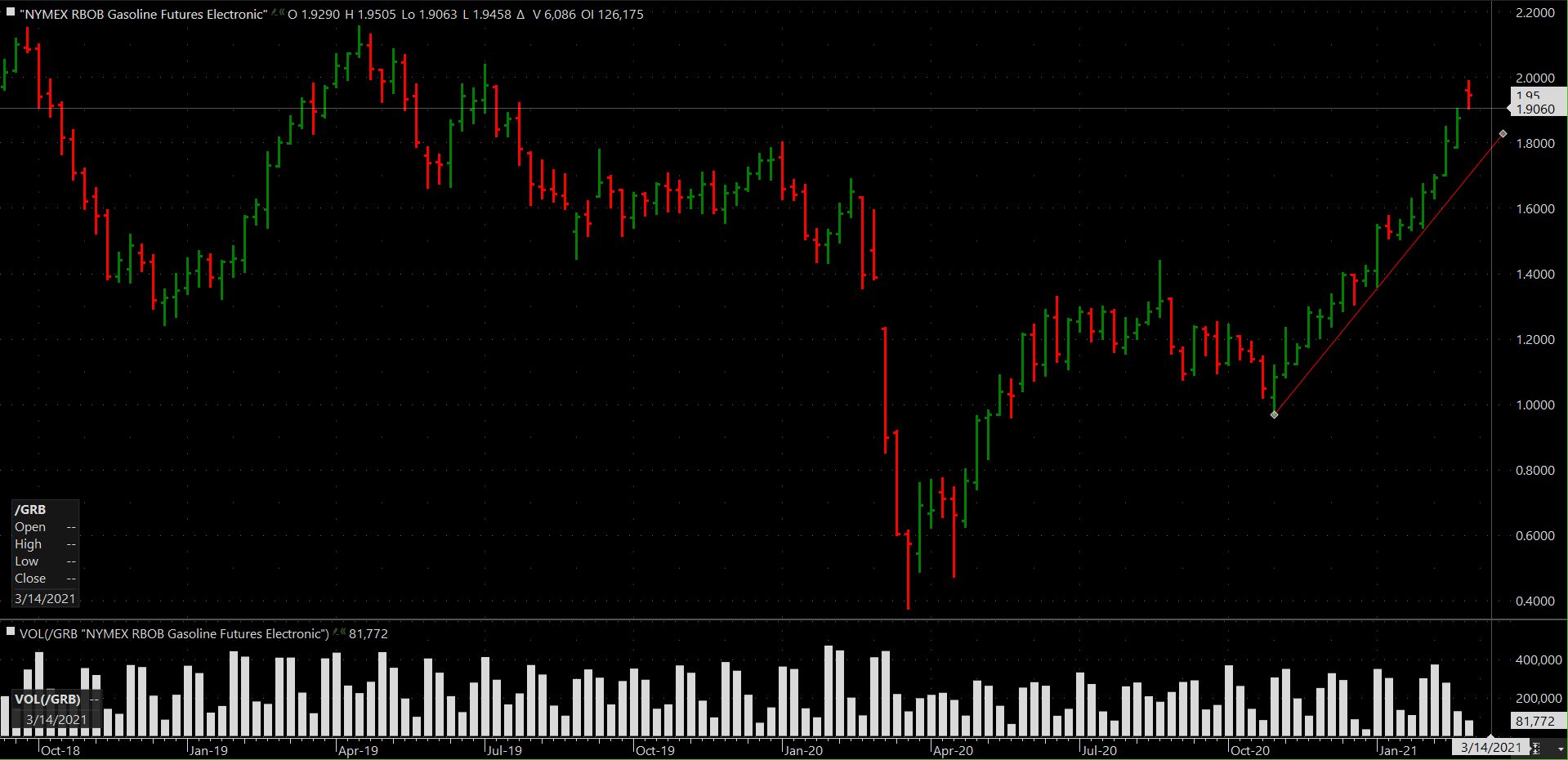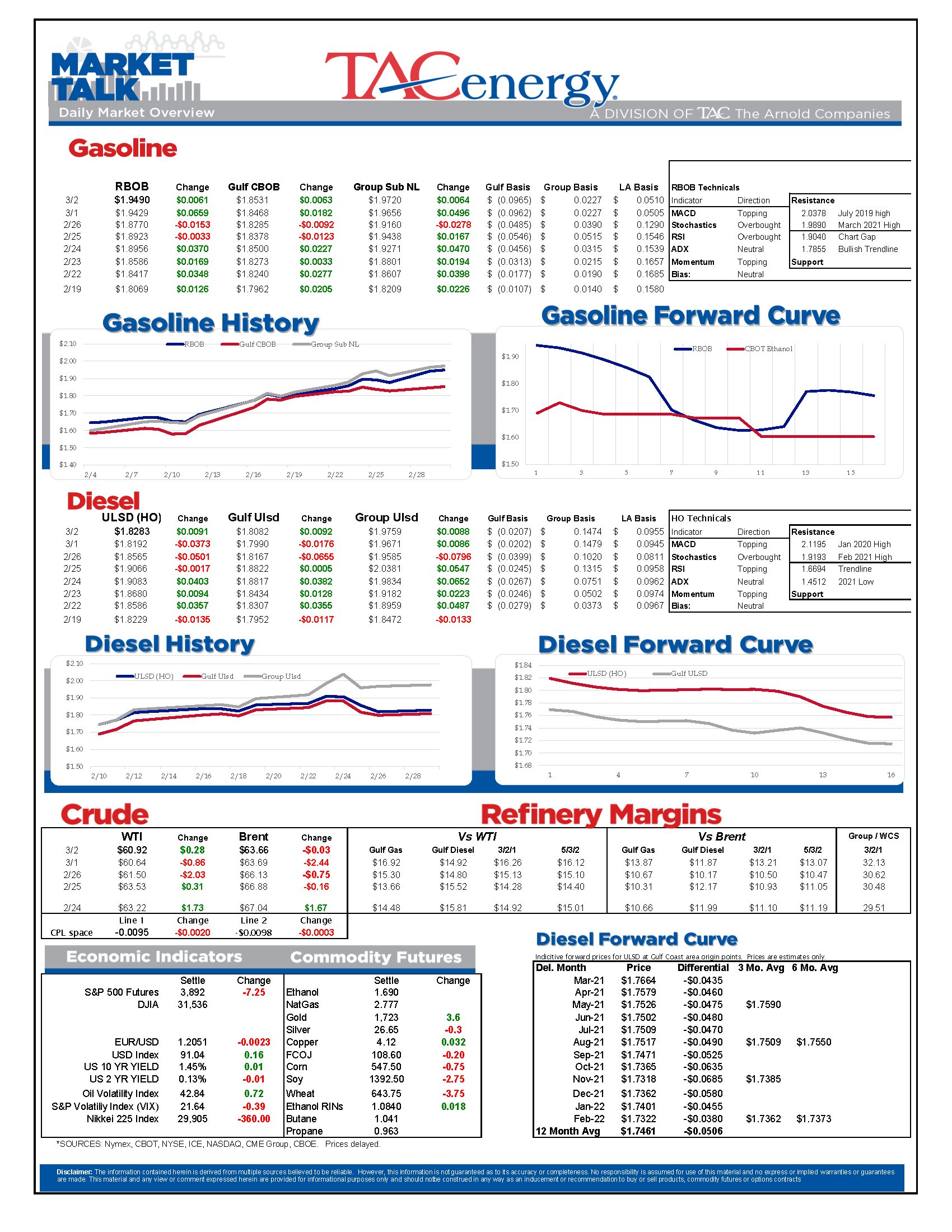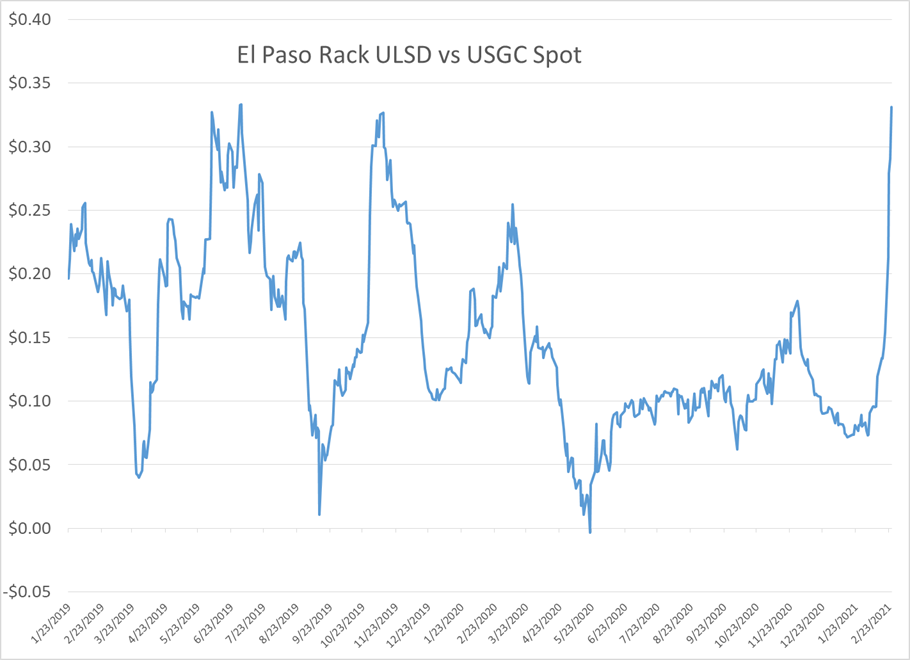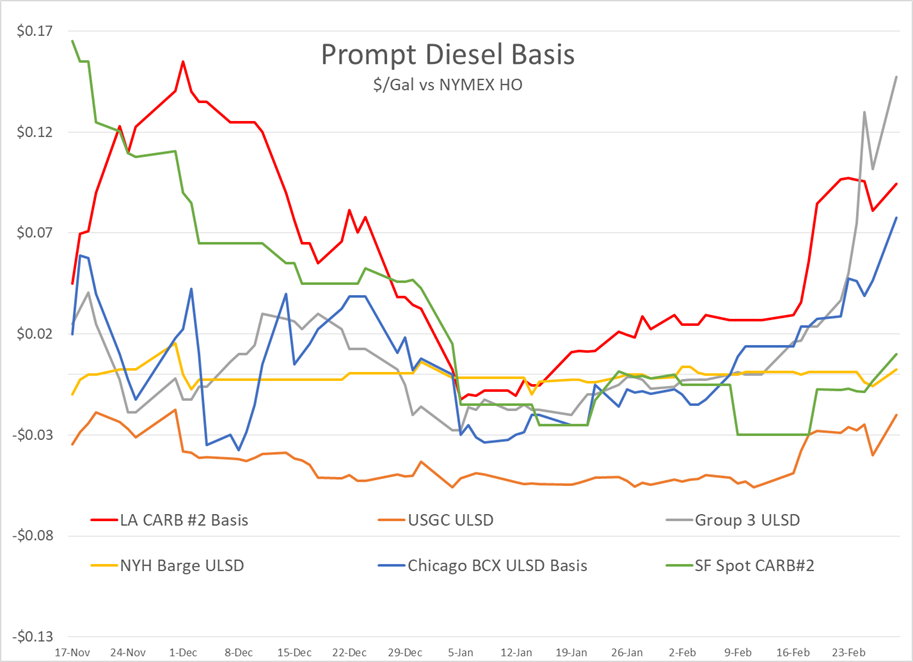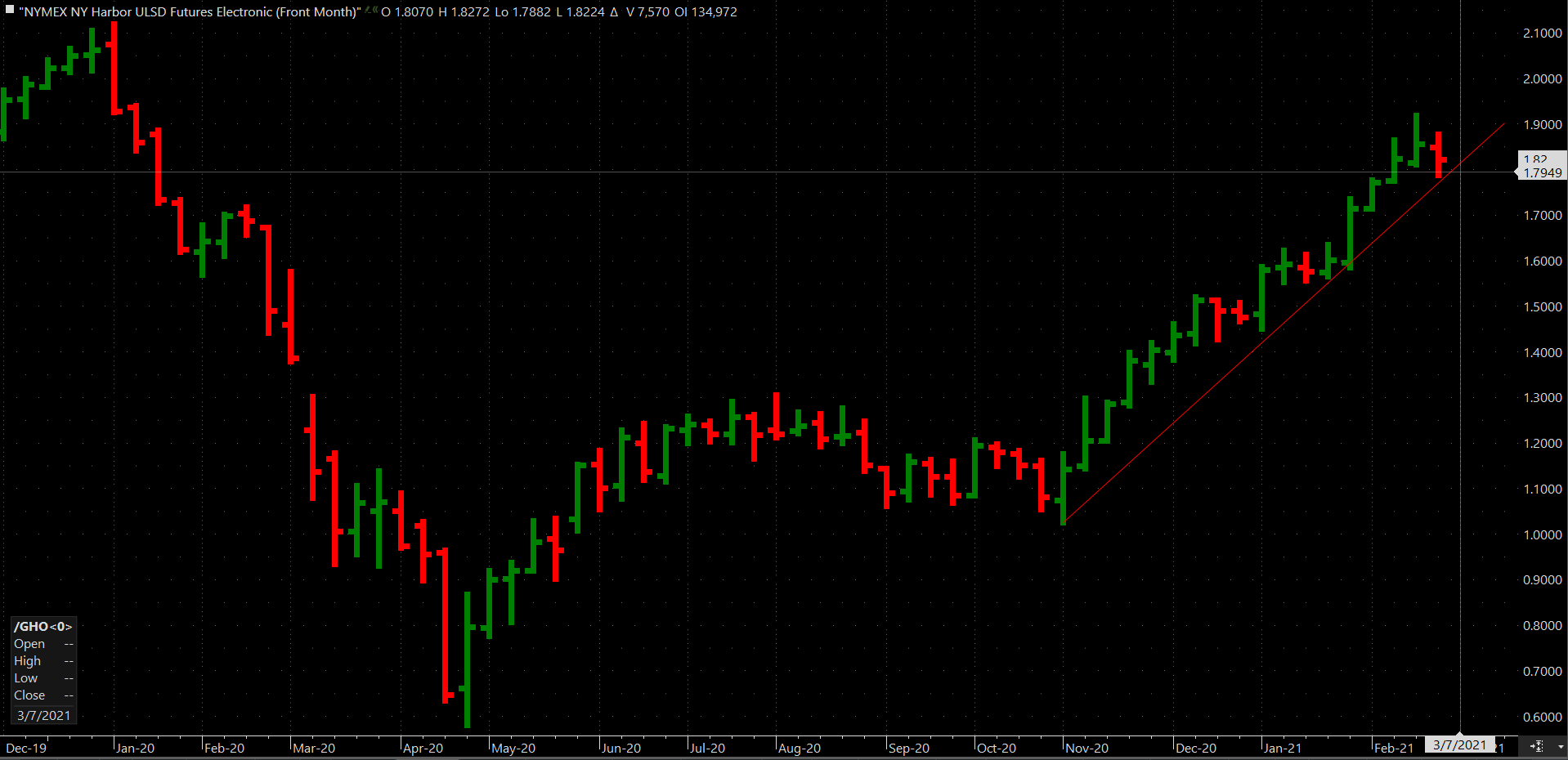Large Plants Shutter After Polar Plunge

It’s a quiet morning in energy markets, after a busy overnight session had petroleum futures on the verge of breaking their four-month-long bullish trend that has nearly doubled the value of some contracts.
Refined products dropped more than three cents overnight, and WTI dropped back below $60, but all three contracts were able to bounce and are trading slightly higher this morning. The overnight sell-off just about closed the chart gap left behind by the transition from winter to summer spec gasoline for the RBOB contract, and ULSD survived its latest test of its bullish trend line, marking the first time since the end of January we’ve seen that weekly trend face a serious test.
The refinery restarts are continuing with some of the largest plants shuttered by the polar plunge coming back online in the past several days. While those restarts are helping alleviate concerns of long term outages, it will still be weeks before we see production return to pre-storm levels, and several reported hiccups are keeping supplies tight across Texas and neighboring states for the time being. The chart below shows the dramatic change in West Texas where diesel supplies went from feast to famine since the cold snap.
Midwestern diesel values continue to spike with Group 3 values reaching their highest levels in more than four years this week as refiners scramble to replace barrels lost due to downtime of their plants, the Explorer pipeline shutting for nearly a week, or the rush to resupply Texas. It’s highly unusual for Group 3 prices to be the most expensive in the country, and is unheard of for February. The only times we’ve seen anything like this is during the fall harvest demand spike. The best cure for high prices is high prices, and we’re already seeing deliveries into the region tick up as shippers capture a rare winter arbitrage, so that price spike may only last another few days.
Things are getting personal in the public argument between refiners CVR and Delek. CVR (fka Coffeyville resources) as a major shareholder in Delek has been taking an activist stance for some time, and now this week publically questioned the CEO of Delek’s compensation package. Not going down without a fight, Delek responded that its performance over the past five years was more than 3X that of CVR and would reply to their request in due course. Does any of this matter to the supply network? Probably not unless CVR gets control of Delek and puts some of its refineries on the chopping block.
The latest in a growing list of refinery unit conversions: Shell announced plans to upgrade its hydrogen plant in Germany to help produce more power-to-liquid aviation fuel. Here’s why oil executives think demand for crude will continue to grow despite the rapidly changing refinery landscape.
Today’s interesting read: Why America needs more mines if its electric dreams are to become reality, and why that’s a huge problem for the “Green” energy movement.
Click here to download a PDF of today's TACenergy Market Talk.
Latest Posts
Week 16 - US DOE Inventory Recap
Energy Markets Trading Quietly In The Red As Ethanol Prices Rally To Five-Month High
The Struggle For Renewable Producers Continues As A Rapid Influx Of Supply And Crashing Credit Prices Make Biodiesel
After Years Of Backwardation, Diesel Prices Have Slipped Into Contango Over The Past Week
Social Media
News & Views
View All
Week 16 - US DOE Inventory Recap

Energy Markets Trading Quietly In The Red As Ethanol Prices Rally To Five-Month High
Energy markets are trading quietly in the red to start Wednesday’s session after a healthy bounce Tuesday afternoon suggested the Israel-Iran-linked liquidation had finally run its course.
There are reports of more Ukrainian strikes on Russian energy assets overnight, but the sources are sketchy so far, and the market doesn’t seem to be reacting as if this is legitimate news.
Ethanol prices have rallied to a 5-month high this week as corn and other grain prices have rallied after the latest crop progress update highlighted risks to farmers this year, lower grain export expectations from Ukraine, and the approval of E15 blends this summer despite the fact it pollutes more. The rally in grain and renewables prices has also helped RIN values find a bid after it looked like they were about to test their 4-year lows last week.
The API reported small changes in refined product inventories last week, with gasoline stocks down about 600,000, while distillates were up 724,000. Crude oil inventories increased by 3.2 million barrels according to the industry-group estimates. The DOE’s weekly report is due out at its normal time this morning.
Total reported another upset at its Port Arthur refinery that’s been a frequent flier on the TCEQ alerts since the January deep freeze knocked it offline and damaged multiple operating units. This latest upset seems minor as the un-named unit impacted was returned to normal operations in under an hour. Gulf Coast basis markets have shrugged off most reports of refinery upsets this year as the region remains well supplied, and it’s unlikely we’ll see any impact from this news.
California conversely reacted in a big way to reports of an upset at Chevron’s El Segundo refinery outside of LA, with CARBOB basis values jumping by more than a dime. Energy News Today continued to show its value by reporting the upset before the flaring notice was even reported to area regulators, proving once again it’s ahead of the curve on refinery-related events. Another industry news outlet meanwhile struggled just to remember where the country’s largest diesel seller is located.
Click here to download a PDF of today's TACenergy Market Talk

The Struggle For Renewable Producers Continues As A Rapid Influx Of Supply And Crashing Credit Prices Make Biodiesel
The sigh of relief selloff continues in energy markets Tuesday morning, with gasoline prices now down more than 20 cents in 7 sessions, while diesel prices have dropped 26 cents in the past 12. Crude oil prices are within a few pennies of reaching a 1 month low as a lack of headlines from the world’s hot spots allows some reflection into the state of the world’s spare capacity for both oil and refined products.
Gasoline prices are trading near a 6-week low this morning, but still need to fall about another nickel in order to break the weekly trendline that pushed prices steadily higher since December. If that trend breaks, it will be safer to say that we saw the end of the spring gasoline rally on April 12th for the 2nd year in a row. Last year RBOB futures peaked on April 12 at $2.8943 and bottomed out on May 4th at $2.2500. The high (at this point) for this year was set on April 12th at $2.8516, and the low overnight was $2.6454.
It’s not just energy commodities that are seeing an unwind of the “flight to safety” trade: Gold prices had their biggest selloff in 2 years Monday and continue to point lower today. Just how much money poured into commodities in the weeks leading up to the direct confrontation between Israel and Iran is unclear, but we have seen in year’s past that these unwind-events can create a snowball effect as traders can be forced to sell to cover their margin calls.
Supply > Demand: The EIA this morning highlighted the record setting demand for natural gas in the US last year, which was not nearly enough to offset the glut of supply that forced prices to a record low in February. A shortage of natural gas in Europe was a key driver of the chaotic markets that smashed just about every record in 2022, and an excess of natural gas supply in Europe and the US this year is acting as a buffer, particularly on diesel prices.
The struggle for renewable producers continues as a rapid influx of supply and crashing credit prices make Biodiesel, RD and SAF unprofitable for many. In addition to the plant closures announced in the past 6 months, Vertex Energy reported Monday it’s operating its Renewable Diesel facility in Mobile AL at just 50% of capacity in Q1. The truly scary part for many is that the $1/gallon Blender's tax credit ends this year and is being replaced by the “Clean” Fuel production credit that forces producers to prove their emissions reductions in order to qualify for an increased subsidy. It’s impossible to say at this point how much the net reduction will be for domestic producers, but importers will get nothing, and at current CI values, many biodiesel producers may see their “blend credit” cut by more than half.
Click here to download a PDF of today's TACenergy Market Talk.
